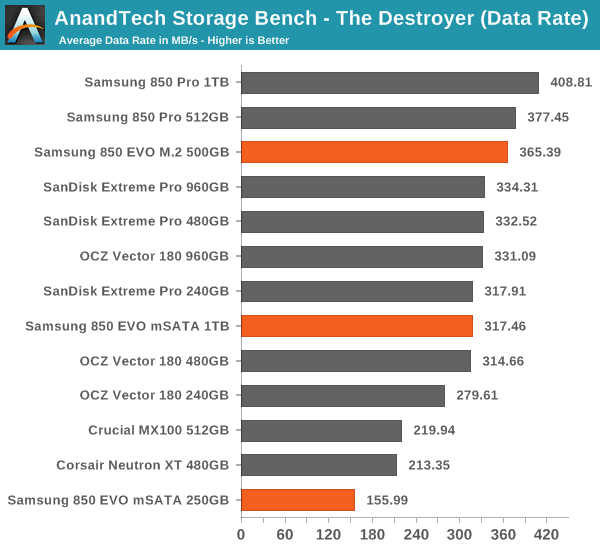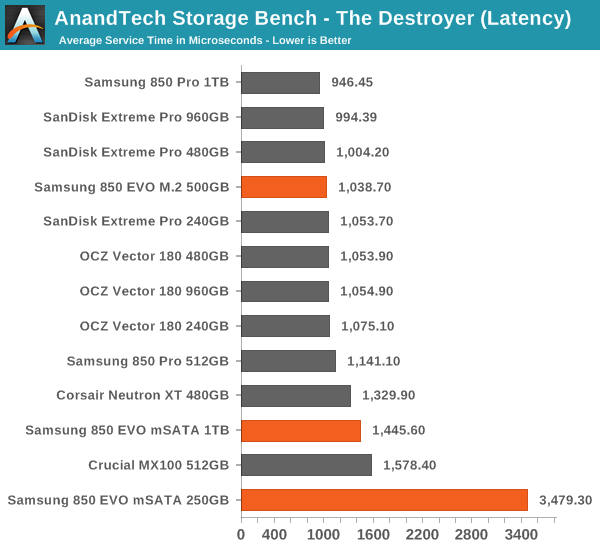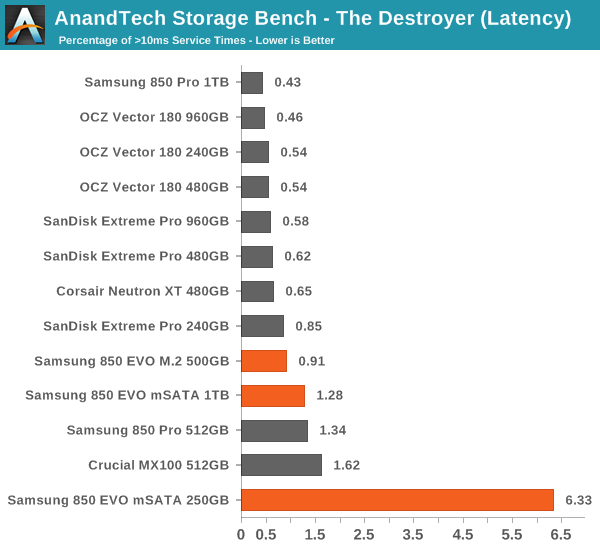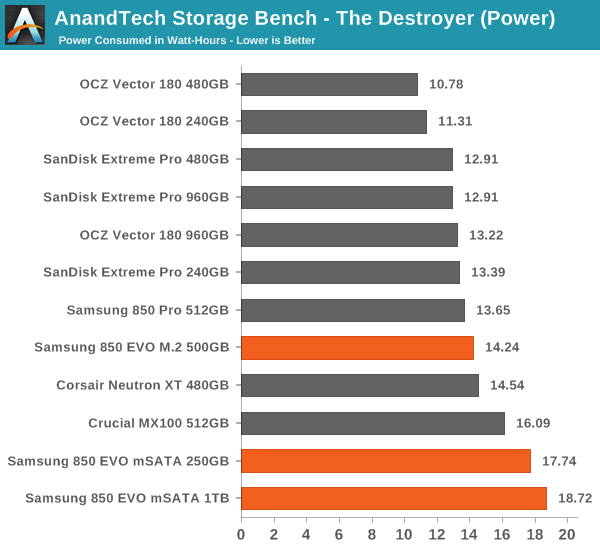The Samsung SSD 850 EVO mSATA/M.2 Review
by Kristian Vättö on March 31, 2015 10:00 AM ESTAnandTech Storage Bench - The Destroyer
The Destroyer has been an essential part of our SSD test suite for nearly two years now. It was crafted to provide a benchmark for very IO intensive workloads, which is where you most often notice the difference between drives. It's not necessarily the most relevant test to an average user, but for anyone with a heavier IO workload The Destroyer should do a good job at characterizing performance.
| AnandTech Storage Bench - The Destroyer | ||||||||||||
| Workload | Description | Applications Used | ||||||||||
| Photo Sync/Editing | Import images, edit, export | Adobe Photoshop CS6, Adobe Lightroom 4, Dropbox | ||||||||||
| Gaming | Download/install games, play games | Steam, Deus Ex, Skyrim, Starcraft 2, BioShock Infinite | ||||||||||
| Virtualization | Run/manage VM, use general apps inside VM | VirtualBox | ||||||||||
| General Productivity | Browse the web, manage local email, copy files, encrypt/decrypt files, backup system, download content, virus/malware scan | Chrome, IE10, Outlook, Windows 8, AxCrypt, uTorrent, AdAware | ||||||||||
| Video Playback | Copy and watch movies | Windows 8 | ||||||||||
| Application Development | Compile projects, check out code, download code samples | Visual Studio 2012 | ||||||||||
The table above describes the workloads of The Destroyer in a bit more detail. Most of the workloads are run independently in the trace, but obviously there are various operations (such as backups) in the background.
| AnandTech Storage Bench - The Destroyer - Specs | ||||||||||||
| Reads | 38.83 million | |||||||||||
| Writes | 10.98 million | |||||||||||
| Total IO Operations | 49.8 million | |||||||||||
| Total GB Read | 1583.02 GB | |||||||||||
| Total GB Written | 875.62 GB | |||||||||||
| Average Queue Depth | ~5.5 | |||||||||||
| Focus | Worst case multitasking, IO consistency | |||||||||||
The name Destroyer comes from the sheer fact that the trace contains nearly 50 million IO operations. That's enough IO operations to effectively put the drive into steady-state and give an idea of the performance in worst case multitasking scenarios. About 67% of the IOs are sequential in nature with the rest ranging from pseudo-random to fully random.
| AnandTech Storage Bench - The Destroyer - IO Breakdown | |||||||||||
| IO Size | <4KB | 4KB | 8KB | 16KB | 32KB | 64KB | 128KB | ||||
| % of Total | 6.0% | 26.2% | 3.1% | 2.4% | 1.7% | 38.4% | 18.0% | ||||
I've included a breakdown of the IOs in the table above, which accounts for 95.8% of total IOs in the trace. The leftover IO sizes are relatively rare in between sizes that don't have a significant (>1%) share on their own. Over a half of the transfers are large IOs with one fourth being 4KB in size.
| AnandTech Storage Bench - The Destroyer - QD Breakdown | ||||||||||||
| Queue Depth | 1 | 2 | 3 | 4-5 | 6-10 | 11-20 | 21-32 | >32 | ||||
| % of Total | 50.0% | 21.9% | 4.1% | 5.7% | 8.8% | 6.0% | 2.1% | 1.4 | ||||
Despite the average queue depth of 5.5, a half of the IOs happen at queue depth of one and scenarios where the queue depths is higher than 10 are rather infrequent.
The two key metrics I'm reporting haven't changed and I'll continue to report both data rate and latency because the two have slightly different focuses. Data rate measures the speed of the data transfer, so it emphasizes large IOs that simply account for a much larger share when looking at the total amount of data. Latency, on the other hand, ignores the IO size, so all IOs are given the same weight in the calculation. Both metrics are useful, although in terms of system responsiveness I think the latency is more critical. As a result, I'm also reporting two new stats that provide us a very good insight to high latency IOs by reporting the share of >10ms and >100ms IOs as a percentage of the total.
I'm also reporting the total power consumed during the trace, which gives us good insight into the drive's power consumption under different workloads. It's better than average power consumption in the sense that it also takes performance into account because a faster completion time will result in less watt-hours consumed. Since the idle times of the trace have been truncated for faster playback, the number doesn't fully address the impact of idle power consumption, but nevertheless the metric is valuable when it comes active power consumption.

The pausing issue of the 1TB 850 EVO mSATA also translates straight to our The Destroyer trace. While higher capacities are usually faster than smaller capacities in this test, the 1TB mSATA is about 15% slower than the 500GB M.2. Generally speaking the 850 EVO does very well at 500GB and above, but since Samsung's TLC V-NAND is 128Gbit in capacity and single-plane, the 250GB can't keep up with drives that are using smaller capacity NAND for higher parallelism.

The latency graph further illustrates the poor performance of the 1TB mSATA, but quite surprisingly the 500GB 850 EVO is actually faster than the 512GB 850 Pro. I suspect the additional over-provisioning helps because The Destroyer is a very intensive trace that practically puts the drive into steady-state .

The share of high latency IOs is a bit high, but nothing to be concerned of. Only the 250GB model has a significant amount of >10ms IOs and for IO intensive workloads I would strongly advise to go with 500GB or higher.

Active power consumption seems to be quite high for the 850 EVO, although I'm not surprised since TLC generally consumes more power than MLC due to its inherent design (more program pulses needed to achieve the final voltage state).











58 Comments
View All Comments
nmm - Tuesday, March 31, 2015 - link
Uninteresting releases like this are the reason M.2 is having so much trouble gaining traction. Desktop users have no reason to choose the M.2 variant since they'll get similar performance out of a much more versatile SATA variant. The only obvious reason I can see to buy mSATA/M.2 versions of this drive is if you've got a laptop that can't slot a regular 2½" SATA drive. What a waste of shelf space.bricko - Tuesday, March 31, 2015 - link
These are all way slow and almost outdated. INTEL and others coming out with NVMe and PCIe 3 stuff that are 2 to 4 times as fast. Big event from INTEL listed here.http://www.pcper.com/news/General-Tech/PCPer-Live-...
Best to have an X99 mobo to make them bootable. Lots of these m.2 stuff is not bootable without lots of bios messing etc. Lots of info here
http://www.thessdreview.com/our-reviews/intel-ssd-...
http://hothardware.com/reviews/Intel-SolidState-Dr...
blanarahul - Tuesday, March 31, 2015 - link
Those drives will cost upwards of 0.8$/GB. So you can't really compare those drives with these ones.Not to mention, they would be HHHL cards instead of M.2 and they use 20nm NAND which is almost 2 generations old.
bricko - Tuesday, March 31, 2015 - link
Many of the m.2 sticks run very hot and manu are insertin g them into adapter cards to fit in pcie slot.Here is link to one....but its been removed from server and being sold before the consumer version is out. The cost is enormous because no other supply yet, but should be out to consumer in day or 2.
http://www.amazon.com/dp/B00L0LFKQW/ref=wl_it_dp_o...
here is m.2 adapter card with heat sink for the samsung 941 ssd drive to put into pcie slot
http://www.amazon.com/Sintech-PCI-e-Adapter-Samsun...
but again, these early ones are difficult to make bootable, need x99 mobo and to get the nvme you need windows 8.1 which has native driver.
bricko - Tuesday, March 31, 2015 - link
Here is link to intels countdown clock for their big announcement on m.2 ssdhttp://www.intelgamingpromo.com/intel15b/ssd/notic...
bricko - Wednesday, April 1, 2015 - link
Mushkin Hyperion M.2 SSD Reaches 2.8GB/s and 350K IOPShttp://www.thessdreview.com/daily-news/latest-buzz...
Kristian Vättö - Wednesday, April 1, 2015 - link
While I'm under NDA for that announcement, what I can tell you is that there's no M.2 coming tomorrow.bricko - Wednesday, April 1, 2015 - link
Good explanation on how and what these new m.2 drives are and what you need to get them to work.http://www.tomshardware.com/answers/id-2468965/ssd...
SunLord - Tuesday, March 31, 2015 - link
I was so hoping to see a m.2 42mm option from Samsung...WackyDan - Tuesday, March 31, 2015 - link
Same here... So these aren't available in 42mm?